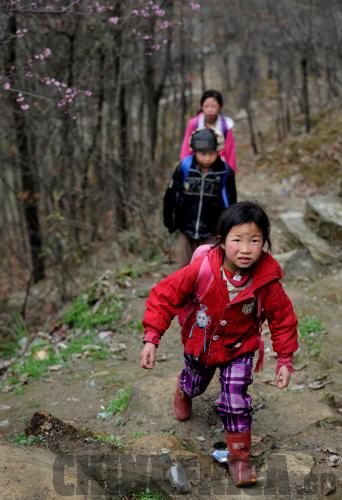|
|

|
|
WALK THE WALK:It's an arduous journey to get to school for rural students in Guangxi Zhuang Autonomous Region (TAO MING) |
Li Bingbing, 10, gets up at 6:30 every morning, washes, dresses and has breakfast. Then her grandmother takes her to school 2 km away. Li is a third-grade learner at the Central Primary School in Liucun Village of Xingtai City in north China's Hebei Province. The school is a merger of eight schools in nearby villages catering for children from grade one to six.
"I like to go to school as I can play games with my pals. But I have to walk to school for such a long time. It is so tiring," Li told ChinAfrica. Like her, all the learners walk to school, spending an average of an hour on the one-way journey.
However, compared to Li and her schoolmates, many rural schoolchildren in China are not so lucky. They have to travel along tortuous mountain trails of dozens of km to attend school. The frequent schoolbus accidents making news since last year have added to public worries about the safety of this transportation.
A policy in education about 10 years ago is at the root of this strain on learners. In 2001, a regulation by the State Council, China's Central Government, said the location of schools providing compulsory education should be adjusted according to local conditions so as to improve education quality of rural schools by pooling high-quality teaching resources. In the same year, merger of rural schools were listed as a priority to develop rural compulsory education. Since then, the program of closing and merging schools has been practiced across the country's rural areas.
According to statistics released by the Ministry of Education, China had 440,282 rural primary schools in 2000, while the number dropped to 210,894 in 2010, down 52.1 percent. In about 10 years, half of the previous rural primary and middle schools were closed or merged.
Optimizing resources
During the process of China's rapid urbanization, more and more farmers immigrated to cities. Meanwhile, the strict family planning policies led to reduction of the birth rate in rural areas, causing the number of rural students to continue to fall. "Under such circumstances, the closure and merger of rural schools are in line with social development, as it helps optimize allocation of education resources and can better meet rural residents' need for education," Li Liyan, a news commentator, told People's Daily.
"I love my school, as there are spacious classrooms and various sports facilities," said Li Bingbing. The previous primary school in her village was near her home and it only took a five-minute walk. But it was too small, with no playground, let alone sports facilities such as a football field. Students had no place for the PE class.
The problem of teacher shortages was alleviated after the closure and merger of smaller schools. Since Li Hao, Li Bingbing's brother, 17, was in primary school, the number of school-age children in his village has been dropping dramatically. At the worst scenario, there were not enough students for even one class in each grade. In neighboring Liufangcun Village, which has a smaller population, students of different grades had to share one classroom, and one teacher was asked to teach two to three different subjects.
"Now the problem is solved. We have individual teachers for each subject. Moreover, the teaching of art and music get more interesting and regular as we now have professional teachers," Wang Qiaoling, a teacher from the Central Primary School, told ChinAfrica.
|